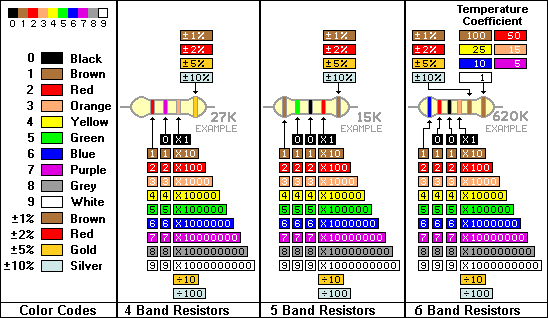Resistor color code
How does the resistor color code work?
Resistors value often indicated with color codes. Practically all leaded resistor with a power rating up to 1 watts are marked with color bands. The coding is defined in the international standard IEC 60062. This standard describes the marking codes for resistors and capacitors. It includes also numerical codes, as for example often used for SMD resistors. The color code is given by several bands. Together they specified the resistance value, the tolerance and sometimes the reliability or failure rate. The number of bands varies from three till 6. As a minimum, two bands indicate the resistance value and one band serves as multiplier. The resistance values are standardized, these values are called preferred value.
Resistor color code chart
The chart below shows how to determine the resistance and tolerance for resistors. The table can also be used to specify the color of the band when the values are known. An automatic resistor calculator can be used to quickly find the resistor values.
Tips for reading resistor code
In the selection below examples are given for different numbers of bands, but first some tips are given to read the color code:
- The reading direction might not always be clear. Sometimes the increased space between band 3 and 4 give away the reading direction. Also, the first band is usually the closest to a lead. A gold or silver band (the tolerance) is always the last band.
- It is a good practice to check the manufacturer's documentation to be sure about the used color coding system. Even better is to measure the resistance with a multi-meter in some cases this might even be the only way to figure out the resistance;
For example when the color bands are burnt off.
4 band resistor
The four band color code is a most common variation. This resistors have two bands for the resistance value, one multi-meter and one tolerance band.
In the example on the left these band are green, blue, red and gold. By using the color code chart, One find the green stands for 5 and blue for 6. The value is the 56.100= 5600Ω. The golden band means that the resistor has a tolerance of 5%. The resistance value lies therefore between 5320 and 5880Ω.
If the tolerance band would be left by blank, the result is a 3 band resistor. This means that the resistance value remains the same, but the tolerance is 20%.
5 band resistor
Resistors with high precision have an extra band to indicate a third significant digit. Therefore, the first three bands indicate the significant digits, the 4th band is the multiply factor and fifth band is represents the tolerance. There are exception to this. For example, sometimes the extra band indicates failure rate (military specification) or temperature coefficient (older or specified specialized resistor)
Shown an example: brown (1), yellow (4), purple (7), black (x1), green (0.5%) :147Ω0.5%.
6 band resistor
Resistors with 6 band are usually for high-precision resistors that have an additional band to specify the temperature coefficient PPM/K. The most common colour for the 6 band is brown (100 PPM/K). This means that for a temperature change of 10 ˚C, the resistance value can change 0.1%. For special applications where the temperature coefficient is critical other colors.
Show an example: Orange (3), red (2), brown (1), green (x10), brown (1%), red (50 PPM/K): 3.21 kΩ 1% 50 PPM/K.
Combine Chart for 4 band, 5 band, and 6 band Resistor:
Color code explanation exceptions
Reliability band
Resistors that are produced according to military specifications, sometimes include and extra band to indicate reliability. This is specified in failure rate (%) per 1000 Hours of service. This is rarely used in commercial electronics. Mostly the reliability band can be found on four band resistors. More information about the reliability can be found in the US military handbook MIL-HDBK-199.
Single black band or zero ohm resistor
Resistor with a single black band is called a zero ohm resistor. Principally it is a wire linked with only function of connecting traces on the PCB. Using the resistor package has the advantage of being able to use the same automated machines to place component on the circuit board.
5 band resistor with a 4 band of gold or silver
5 band resistors with 4th band of gold or silver form an exception, and are used on specialized and older resistors. The first two band represent the significant digits, the 3rd the multiple factor, and forth the tolerance and 5th is the temperature coefficient (PPM/K).
Deviating colors
For high voltage resistors often the colors gold and silver are replaced with yellow and grey. This is to prevent having metal particles in the coating.






No comments:
Post a Comment